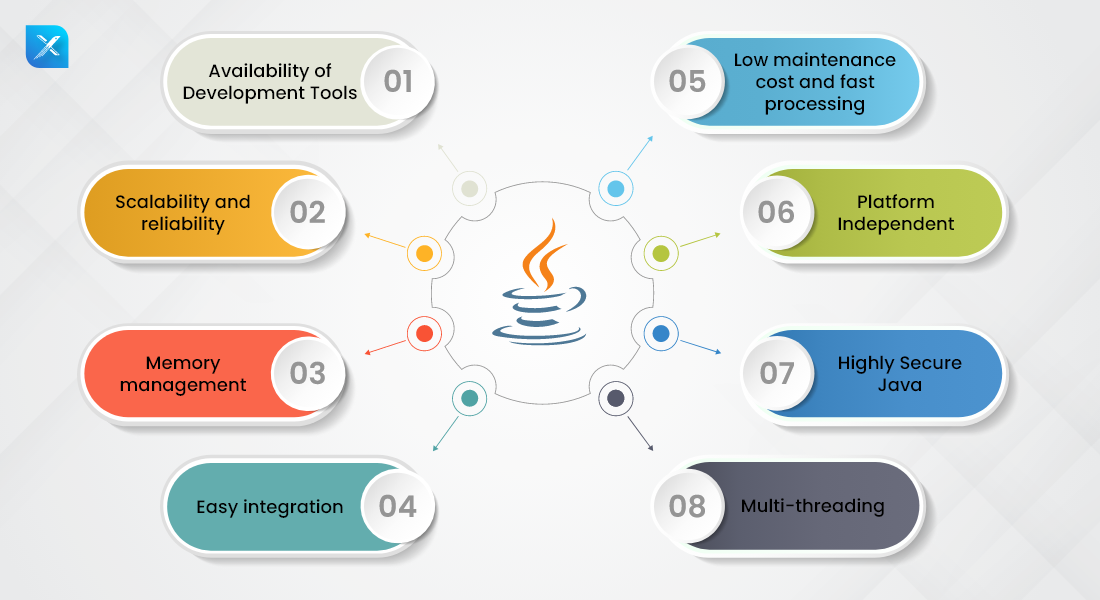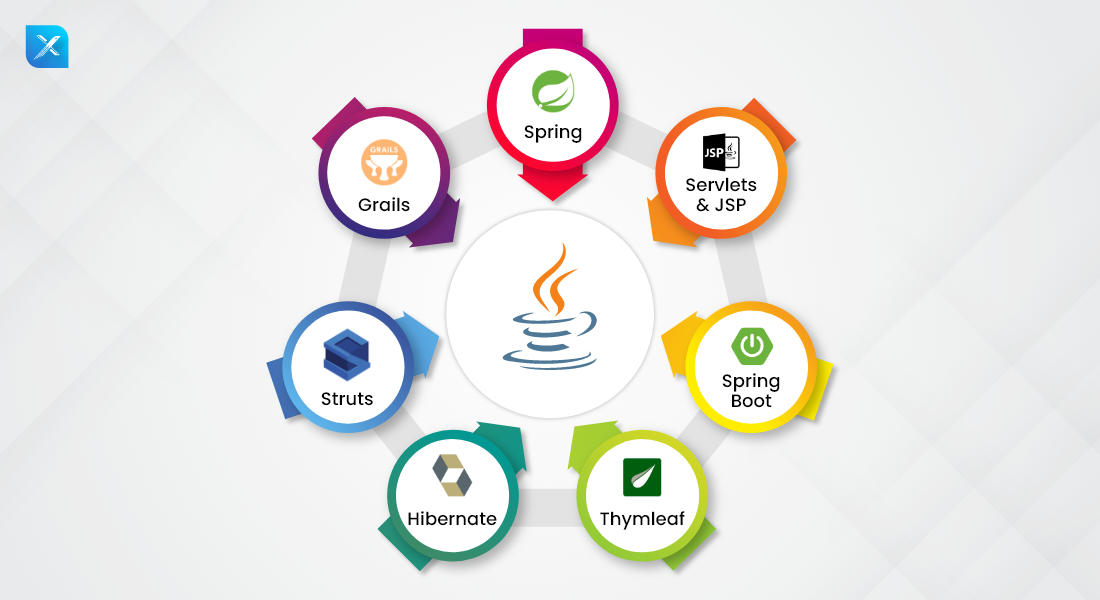AI Implementation in Business: 10...
July 14, 2025

Java is the fifth most often used coding language in the world as of 2021. Thousands of businesses employ Java web development services nowadays to create digital goods and solutions. Java has been a key component of the technology stack for creating an enterprise-level web application.
In order to manage various divisions, digitize processes, and improve organizational workflow, businesses need enterprise systems. They must be easy for teams to run and scalable, reliable, and intuitive. By digitizing their business processes using a solitary, integrated system, firms can realize functional benefits thanks to Java enterprise software development.
Surveys show that 58 percent of businesses utilize Java as part of their IT stack. Java has a vast amount of experience because it has been used by developers for more than 20 years. A Java team that can create speedier apps and help them stay ahead of the competition is needed for enterprise-grade solutions.
Java has been used as the most popular programming language for many years. It is acknowledged as the top most demanded language by enterprises. No business will dispute that Java is the most helpful language for developing sturdy systems. Java provides a scalable, flexible, and dependable program for various business needs. Through this open-source language any type of enterprise web app, android apps, IoT based apps can be prepared easily. All of these apps are essentially built on Java. To get a quality application, work with experienced full-stack developers who are familiar with the programming language from scratch.
Java is incredibly reliable and offers its users creativity, adaptability, and enhanced efficiency in enterprise-level web applications. Consumer applications just aim to provide the best possible user experience, whereas business applications need to boost worker productivity, operational efficiencies, and many other factors. Large companies are known to rely heavily on Java. They can’t be mistaken, which means that there are valid arguments for why Java should stand alone and why users will favor Java above other languages. The explanations are as follows:

Software developers must create complicated systems with vast and simple-to-customize functionality since enterprise apps carry out a wide range of business tasks, including data gathering, planning, production management, and many more. For creating functionality of any complexity, Java provides a sizable number of libraries, APIs, IDEs, and frameworks. Additionally, Java developers may create apps much more quickly and with fewer difficulties and potential errors thanks to a variety of tools.
The chosen framework must have enough performance to support workloads at an enterprise scale. Java was simply the best option for enterprise-size development, barring business logic. Java provides a scalable architecture with a variety of frameworks, applications, and libraries that can accommodate any enterprise requirement.
Any corporate software solution starts with libraries as its fundamental building piece. As compared to others, this language can resolve practically all of the frequent issues that developers encounter. Because Java is so scalable, businesses may easily ramp up their applications during peak seasons.
We’ll try to make the technical aspects of Java’s memory management more understandable. All Java objects are kept in a structure known as a “heap” in Java programming. A heap is created when a web application first launches, and depending on how it is used, it may grow or shrink. The “trash” is gathered and dumped once the mound is full. To make room for new things to enter, objects that are no longer in use are eliminated.
Other features of this include the “nursery,” where the more recent items are kept, and the “prior space,” where the room’s older items are stored until being thrown out. The key aspect is that there is a system for managing memory automatically.
Web applications can usually be hosted by the hosting providers that support Java code. As a result of having a common application binary interface, Python and Java complement each other, and tools exist to help with the integration of other programming languages, as a match between the signatures of the languages is important. With essentially minimal technological dependencies, Java can be run on any hardware infrastructure.
Java is fairly affordable compared to other languages because it doesn’t cost much to install and run a Java server. Servers for Windows and Mac cost significantly more. This programming language is appropriate for businesses because it supports hardware devices. Java has no license fees, which saves time and is a relief.
This is one of the main reasons to go with Java as compared to others. Java enables programmers to create code once and reused it in multiple places. Java is portable because of this crucial feature and advantage, which makes it simple to employ in cross-platform applications.
All platforms with a Java virtual machine can run the compiled Java program. Because of this, Java web development companies no longer have to worry about adapting to various hardware or operating systems, nor do they have to deal with the hassle and expense of correcting the incompatibility of already-existing Java-written software.
Due to Java’s excellent level of security, so many developers choose to create Java web applications. Java web application development includes numerous built-in security features such as sophisticated authentication, cryptography, and network management. A developer can use its extensive API, which includes secure login methods, digital signatures, cyphers, the ability to create unique security policies, and more, by utilizing these features.
Java web applications provide the ability to manage several users at once. Instead of needing to run many copies of the codes on the same hardware, it is accomplished by generating threads within the program for each user. Each thread is monitored using this technique until the “task” is complete. Fewer bugs, quicker reaction times, higher performance, and minimal maintenance are all benefits of multi-threading.
Java has several applications in everyday life. As the modern world develops, Java solutions are increasingly common in a variety of industries. The technology is helpful in the creation of applications ranging from whole ERP systems to the digitization of processes in different industry verticals.
Java developers keep significant expertise in the areas of web application development. the server application, embedded systems, GUI development, Big data, and many more. The organization’s digital efforts are worth it when these apps are integrated with enterprise solutions and help them on reaching new heights.
Apart from this, a Java web development company can also provide augmented and virtual reality services. By using Java and its frameworks, these two technologies facilitate the development of advanced models and the integration of 3D dynamics into enterprise software. Get the best enterprise-level web application development services at the best.
Several Java-related web frameworks can be used to develop web applications, but in this article, we’ll focus on the most popular and straightforward ones.

Java is used more quickly, easily, and safely thanks to the Spring framework, which is a strong, lightweight, and well-liked framework. This framework is well-liked by developers for its quickness, ease of use, and productivity, all of which make it possible to easily create enterprise-level online applications. Many technology companies, such as Netflix, Google, Amazon, and Microsoft, use Java to make massive, sophisticated online apps because Spring MVC and Spring Boot help them in making agile, reactive, and cloud-ready apps.
One of the most fundamental Java tools for creating web apps is this one. This outdated tool is no longer used to create applications. But JSP and Servlets have been used to create several significant and successful applications. A Java development company can help you in getting out in getting the best Java web application for your enterprise.
This is one of the most crucial components of the Spring Framework. Spring boot comes with a built-in server and tools that give developers excellent resources for creating high-quality, complex applications. Getting started with the Spring Boot is quite simple. You can get started right now by visiting the Spring Starter website and choosing the libraries you need. Spring Boot is an ideal choice for Java enterprise software development, so can think about it.
Thymleaf is another fascinating tool offered by Java for creating applications. Thymleaf’s ability to operate efficiently with Modern CSS frameworks for modern design needs is its most enjoyable feature. Additionally, it lessens how difficult it is to communicate from a model to a view.
Understanding ORM is necessary in order to comprehend Hibernate. Entities are mapped to databases via object-relational mapping. In very basic terms, we may state that after creating a class, an object from that class is called upon and recorded as a row in the database.
Excellent ORM functionality was offered by Hibernate in the Java environment. It is incredibly simple to use and significantly lowers the cost of Java enterprise web app development. But occasionally, it causes a performance bottleneck.
Hibernate is a totally open-source program that reduces redundancy through JDBC API. It boosts maintainability and productivity and Persistence APIs are supported here.
An open-source MVC framework, it is a highly helpful tool for developing contemporary, enterprise-level Java online applications that prioritize convention over configuration and shorten overall development times. The REST, AJAX, and JSON support plugins are included, and it is simple to combine with other Java frameworks.
Grails is a comprehensive framework that is simple to learn and ideal for people starting in programming. It is fully compatible with Java syntax and can be run on the Java platform. The MVC design pattern is the foundation of this framework.
While Groovy and Java are comparable, Groovy has a few more features. If you are already familiar with Java, learning Groovy is fairly simple.
In Grails, the rendering technique is GSP, like it is in JSP. Here adding tags to the View is a straightforward process. Additionally, it makes use of GORM, which, as you might have guessed, is how Grails implements ORM. Instead of GORM, Hibernate can be used directly. RESTful APIs are already supported by Grails, making it simple to develop such services.
The nicest feature is that you can incorporate your current Java code with Grails. Hence. Your app will run fine if it contains both Groovy and Java code.
The most important arguments for using Java for web development have just been covered. If you want to create a Java-based web application for your organization, Get in touch with a seasoned Java development firm that has had expertise in creating such web applications in the past. You can hire a Java web development company to get relevant support.
